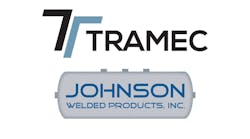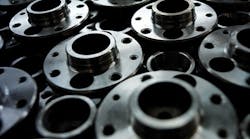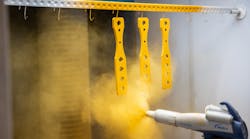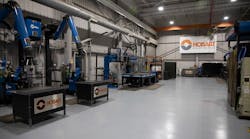Call it glue if you insist, but adhesives increasingly are being used to make trailers stick together, a trio of representatives of 3M said at the NATM convention in Las Vegas.
In a 90-minute presentation, the three offered insights into why adhesives are being used in trailer manufacturing, how trailer manufacturers can use them successfully, and how trailer designs and manufacturing processes can be modified to retain smoothness in trailer sidewalls.
“We like to think of our product as finely tuned, highly engineered, synthetically derived polymer adhesives,” Randy Koza said. “Glue is an older term that usually is referred to as an animal byproduct. But if you want to refer to any sticky stuff as glue, that's okay.”
Koza pointed to successful applications in a wide range of products.
“If you don't have confidence in adhesive bonding, you should not fly in an airplane, live in a house, allow yourself to be transported in a vehicle, take a boat ride, walk near a skyscraper, or walk near highway signs,” he said. “You would be amazed at how prevalent adhesive bonding is in our society.”
A lot of major developments during the past 15 years have addressed some of the shortcomings, including the brittleness and impact resistance of some epoxies.
To demonstrate the strength of bonded joints, the 3M representatives tied a 16-pound bowling ball to a rope to make a pendulum. A volunteer from the audience lifted the bowling ball to a 90° angle and then allowed it to swing into a riveted joint of overlapped sheets of aluminum. The bowling ball ripped through the joint in one swing.
Later in the presentation, the same technique was used to test the strength of a lap joint held together with adhesive tape. The joint withstood multiple impacts from the bowling ball.
The difference is in the amount of clamping area, Koza explained. The head of each screw may have only 1/8" of clamping area. As a result, impacts and other stresses are concentrated in a narrow area. Even with closely spaced screws along the joint line, a taped joint can provide 40 times the surface area.
Some reasons why
Trailer manufacturers use adhesives for bonding roof sheet to roof bows, reflectors and reflective tape, nameplates, labels, sidewall panels, and scuffplate, Koza said. The reasons why include benefits in product and production.
Product advantages include:
- Improved appearance
- Isolation of dissimilar metals reduces corrosion
- Stress is distributed more evenly, enabling the use of thinner materials and composites.
- Reduced noise associated with sidewall panels
- Increased design flexibility.
Adhesives offer production managers a variety of advantages, including:
- They don't require drilling or fastener processing
- They don't require welding
- Reduced plant noise
- Bonding and sealing can be done simultaneously
- With smooth sides, graphics can be installed in less time.
Getting good adhesion
Several key factors determine the success of bonding:
- Know and test the surfaces to be bonded. Not all materials are created equal. They are not the same in terms of:
- Surface energy. This property determines how well the adhesive will bond to the material. Surface energy is a value that can be found in textbooks or on the Internet.
- Surface texture. How smooth is the surface? This is especially important when applying pressure-sensitive tapes. Liquid adhesives flow, enabling them to more easily cover rougher textures. If the texture is relatively rough, use either a liquid adhesive or a soft and thick pressure-sensitive adhesive (PSA) tape, Koza advised.
- Surface integrity — how well the material itself is bonded together.
- Cleanliness of the surfaces to be bonded is critical.
- Surface preparation — All materials should be cleaned before adhesive is applied. Others require more extensive work. But when extra work is needed, it must be done correctly, Koza said.
Two basic methods can be used for preparing the surface — adhesion promoters (also called primers) and abrasion. Adhesion promoters are used primarily for plastic materials that contain substances capable of weakening the bond. Red metals such as brass, copper, and bronze also can corrode and undercut the bond unless adhesion promoters are used. By contrast, aluminum — the metal with the highest surface energy — often can be bonded with little or no surface preparation.
According to 3M, some materials require abrasion to achieve the needed adhesion. However, using a course grit can actually degrade bonding performance by decreasing the area that the adhesive (primarily pressure-sensitive tapes) can contact. For PSA tapes, use a 180 grit or finer.
- Usage rate. When it comes to adhesive bonding, contact area is most important. Double the contact area, and you double the strength of the material.
- Temperature. Liquid adhesives need sufficient heat for the solvent to dry — a need that varies by the amount of humidity in the air. The typical PSA tape needs to be at or above 50° F for proper adhesive flow. Adhesion promoters can help somewhat when the temperature is below 50° F, but not a lot, Koza said.
- The length of time before the joint is first stressed. The time varies by type of adhesive. Find out from the manufacturer the adhesion's build rate in order not to stress the joint too early. As a rule of thumb, adhesives achieve 50% of their strength in the first 20 minutes after application, 75% after the first hour, 90% in one day, and 100% after three days.
Testing the joint
Several types of tests can be conducted to measure the strength of bonded joints.
Shear testing applies a parallel force to the joint. This is the most common test for liquid adhesives. The standard ASTM procedure calls for one-inch square material to be bonded together and pulled apart at a rate of 0.2" per minute. Measure for the peak force.
Tensile tests attempt to pull the material apart.
For tapes, the most common evaluation is a 90° peel adhesion test. The tape — a flexible material, is pulled at a 90° direction from the material over the course of three inches.
When the tests are evaluated, there are two modes of failure — adhesive failure and cohesive failure. Adhesive failures break apart cleanly at the surface of one of the sheets of material. It will leave no residue on either of the two substrates. To address adhesive failures, do at least one of the following: review the combination adhesive and substrates or improve the surface prep that is being performed.
Cohesive failures are those in which the substrate and the material fail. In this case, the adhesive strength of the material is greater than that of the material. One way to solve cohesive failures is to use thicker material for the substrate.
Types of tapes
PSA tapes come in three basic categories:
- Rubber. This is the low end. Use these tapes mostly for indoor applications and limited temperature where they are not exposed to chemicals.
- Acrylic adhesives are the next notch up. They can be used indoors or out and have some degree of chemical resistance.
- Silicone. These are the most expensive.
Acrylic foam tapes are used frequently in trailer manufacturing. Advantages include energy absorption and noise reduction. They seal and adhere simultaneously, and they isolate the surfaces of two different substrates.
Building smooth sides
Adhesives make it possible for trailer sides to be extremely smooth, but differences in thermal expansion rates between steel posts and aluminum sheet make it a challenge to keep the sheet from buckling. Mark Berman and Tim Clemens spent the balance of the presentation describing ways to reduce the problem.
Thermal expansion can be substantial. Trailers can be subjected to operating temperatures between -30° and +180° F.
“That sounds really high, but it is not unusual for a black-sided trailer in the sun to get that hot,” Berman said.
The tape must be able to withstand the different rates at which steel and aluminum expand. Aluminum expands and contracts at a greater rate than steel — almost 1/8" for an 8-ft trailer, Berman said. The expansion is more pronounced for dark-sided trailers because of the additional heat these trailers absorb.
If the panels are constrained, they will delaminate or buckle. Trailer manufacturers have been able to address this issue by designing trailers with floating side panels. Rather than securing the perimeter of the side sheets, the panels are placed in channels built into the trailer extrusions. This allows them to float, expanding or contracting as temperatures change (for details, see story on Cimarron Trailers, May 2005 TBB).
Testing new ideas
Using controlled conditions, digital cameras to record movement in the sheet, and finite element analysis to quantify stresses within the sheet, 3M reached some conclusions about how to address buckling and delamination in smooth-sided trailers.
The best solution, Berman said, is one in which the edges of the sheets are allowed to expand within channels built into trailer extrusions. Recognizing, however, that manufacturers may not want to redesign their extrusions, Berman offered these options:
- Constrained. This design, with the panels completely secured, produces the most sidepanel buckling and delamination.
- Constraint with relief points. This design uses gaps in the acrylic tape at the top and bottom, rather than running tape the full length of the sideposts.
- Constraint with overlapped seams between posts. By placing the seams between the posts, panels can buckle in and out, removing some of the stress on the seams.
3M used finite element analysis to determine minimal length of relief points. The company's test results confirmed that a trailer design that allows the sidesheet to expand or contract within the extrusions provides the best results. Other options include:
- Two-sided constraints. This design uses fasteners through the top and bottom of the sidewall panel. Buckling in the sidewalls occurs, but it can be reduced with relief points or off-post overlap seams.
- One-sided constraints. Fasteners are used either on the top or bottom of the sidewall panel. This design allows for some expansion in the sidewall with minimal buckling.
Calm your horses
Can adhesives make horses more serene? Maybe, according to research conducted by Skip Hartman, an acoustics and vibration specialist.
Hartman measured the sound and vibrations inside a horse trailer held together with pressure-sensitive adhesive tape and compared it with a similar trailer that had been assembled with mechanical fasteners.
Microphones and vibration sensors were mounted in multiple, identical locations throughout both trailers. The result: the adhesively bonded trailer was 41% quieter at highway speeds. Vibration measured approximately 30% less.
“Reduction of noise or vibrations should benefit horses in transit,” says veterinarian Nancy Loving. “Anything we can do to make our animals more comfortable while traveling is a step in the right direction.”
What about showing them reruns of “Mister Ed?”








